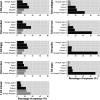Was it a HIIT? A process evaluation of a school-based high-intensity interval training intervention
- PMID: 38684991
- PMCID: PMC11059682
- DOI: 10.1186/s12966-024-01599-2
Was it a HIIT? A process evaluation of a school-based high-intensity interval training intervention
Abstract
Background: Despite a growing body of research investigating high-intensity interval training (HIIT) in schools, there are limited process evaluations investigating their implementation. This is concerning because process evaluations are important for appropriately interpreting outcome findings and augmenting intervention design. This manuscript presents a process evaluation of Making a HIIT, a school-based HIIT intervention.
Methods: The Making a HIIT intervention spanned 8 weeks and was completed at three schools in Greater Brisbane, Australia. Ten classes (intervention group) completed 10-min teacher-led HIIT workouts at the beginning of health and physical education (HPE) lessons, and five classes (control group) continued with regular HPE lessons. The mixed methods evaluation was guided by the Framework for Effective Implementation by Durlak and DuPre.
Results: Program reach: Ten schools were contacted to successfully recruit three schools, from which 79% of eligible students (n = 308, age: 13.0 ± 0.6 years, 148 girls) provided consent. Dosage: The average number of HIIT workouts provided was 10 ± 3 and the average number attended by students was 6 ± 2. Fidelity: During HIIT workouts, the percentage of time students spent at ≥ 80% of maximum heart rate (HRmax) was 55% (interquartile range (IQR): 29%-76%). Monitoring of the control group: During lessons, the intervention and control groups spent 32% (IQR: 12%-54%) and 28% (IQR: 13%-46%) of their HPE lesson at ≥ 80% of HRmax, respectively. Responsiveness: On average, students rated their enjoyment of HIIT workouts as 3.3 ± 1.1 (neutral) on a 5-point scale. Quality: Teachers found the HIIT workouts simple to implement but provided insights into the time implications of integrating them into their lessons; elements that helped facilitate their implementation; and their use within the classroom. Differentiation: Making a HIIT involved students and teachers in the co-design of HIIT workouts. Adaption: Workouts were modified due to location and weather, the complexity of exercises, and time constraints.
Conclusion: The comprehensive evaluation of Making a HIIT provides important insights into the implementation of school-based HIIT, including encouragings findings for student enjoyment and fidelity and recommendations for improving dosage that should be considered when developing future interventions.
Trial registration: ACTRN, ACTRN12622000534785 , Registered 5 April 2022 - Retrospectively registered.
Keywords: Child; Enjoyment; Fidelity; Implementation; Physical education.
© 2024. The Author(s).
Conflict of interest statement
The authors declare that they have no competing interests.
Figures





References
-
- Cassar S, Salmon J, Timperio A, Naylor P-J, Van Nassau F, Contardo Ayala AM, Koorts H. Adoption, implementation and sustainability of school-based physical activity and sedentary behaviour interventions in real-world settings: a systematic review. Int J Behav Nutr Phys Act. 2019;16:120. doi: 10.1186/s12966-019-0876-4. - DOI - PMC - PubMed
Publication types
MeSH terms
LinkOut - more resources
Full Text Sources
Miscellaneous

